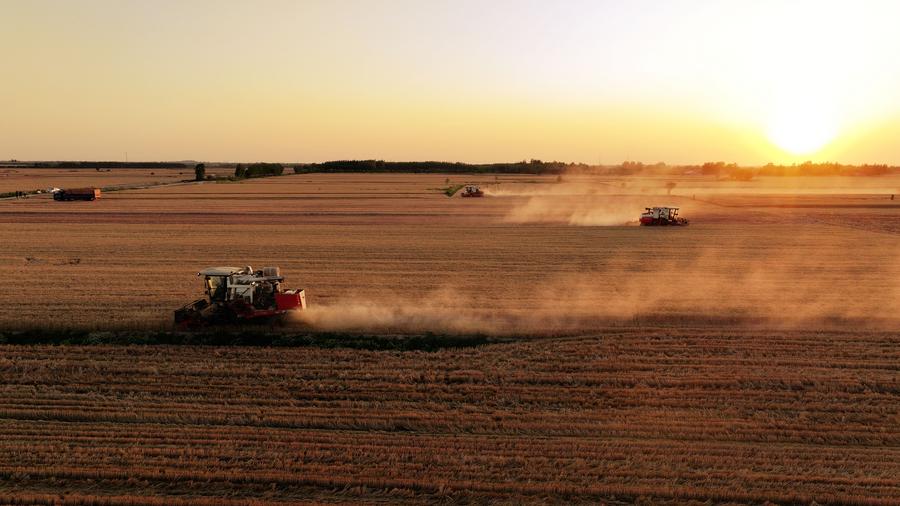
A drone photo taken on June 12, 2025 shows harvesters working in wheat fields in Zhanghuzhuang village of Gaomi city, East China's Shandong province. [Photo/Xinhua]
China has intensified efforts to build a nationwide food loss reduction system that covers production, storage, distribution and consumption, officials said at a recent conference in Shandong province.
The Ministry of Agriculture and Rural Affairs has rolled out targeted strategies along the agricultural supply chain — from field to table — with a focus on improving farm management, disaster prevention, storage and transportation, Vice-Minister Zhang Zhili said.
In 2024, mechanical harvest loss rates for wheat stood at 0.93 percent, rice at 1.76 percent and corn at 2.06 percent — a drop of 1 to 2 percentage points compared with 2021, Zhang said at the 2025 International Conference on Reducing Food Loss and Waste.
More than 25 billion kilograms of grain loss have been prevented in the past three years. Losses due to pests and diseases were kept below 5 percent, and losses in grain and oil processing were reduced to under 1 percent, Zhang added.
At a forum on mechanized loss reduction, Ma Jianhai, head of an agricultural machinery cooperative in Weifang, Shandong, shared how his team improved yields through better equipment and training.
"By improving the skills of machine operators and optimizing agricultural equipment, the cooperative's wheat yield increased from 6 metric tons per hectare to 9 tons, and its corn yield rose from 7.5 tons to 9.7 tons per hectare since it was founded in 2013," Ma said.
Shandong, a major agricultural province and the cradle of traditional Chinese farming, plays a key role in national food production, said Lin Wu, the province's Party secretary.
In recent years, Shandong has accelerated the development of a food-saving system to safeguard food security, Lin said. He highlighted the province's push to promote grain loss reduction technologies.
During the conference, participants visited a digital agriculture demonstration base in Jinan, where an AI-powered platform supports field management. The system enables early warnings and smarter decision-making, helping reduce annual corn losses by 5 percent, according to Chen Xufeng, a representative of the platform's developer.
A South-South cooperation action plan on reducing grain loss was also released during the conference, outlining joint efforts over the next three years in key areas such as digital technology and knowledge sharing.
Li Xiangdong, president of the Shandong Academy of Agricultural Sciences, said he hopes to actively take part in cooperative projects related to grain loss reduction.
"By identifying priority partner countries and carrying out targeted initiatives, we aim to contribute more Chinese solutions to the realization of the 2030 Agenda for Sustainable Development," Li said.
 Editor:Qiu Xiaochen
Editor:Qiu Xiaochen